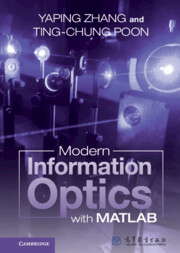Book contents
- Frontmatter
- Dedication
- Contents
- Preface
- 1 Gaussian Optics and Uncertainty Principle
- 2 Linear Invariant Systems and Fourier Analysis
- 3 Wave Propagation and Wave Optics
- 4 Spatial Coherent and Incoherent Optical Systems
- 5 Principles of Coherent Holography
- 6 Digital Holography
- 7 Spatial Light Modulators for Processing Optical Information
- Index
- References
4 - Spatial Coherent and Incoherent Optical Systems
Published online by Cambridge University Press: 22 December 2022
- Frontmatter
- Dedication
- Contents
- Preface
- 1 Gaussian Optics and Uncertainty Principle
- 2 Linear Invariant Systems and Fourier Analysis
- 3 Wave Propagation and Wave Optics
- 4 Spatial Coherent and Incoherent Optical Systems
- 5 Principles of Coherent Holography
- 6 Digital Holography
- 7 Spatial Light Modulators for Processing Optical Information
- Index
- References
Summary
To have some basic understanding of optical coherence, we discuss temporal coherence and spatial coherence quantitatively in the beginning of the Chapter. We then concentrate on spatial coherent image processing, followed by spatially incoherent image processing. While spatial coherent imaging systems lead to the concept of coherent point spread function and coherent transfer function, spatially incoherent imaging system introduces intensity point spread function and optical transfer function. Scanning image processing is also covered in the chapter, illustrating an important aspect in that a mask in front of the photodetector can change the coherence properties of the optical system. Finally, two-pupil synthesis of optical transfer functions is discussed, illustrating bipolar processing in incoherent imaging systems.
Keywords
- Type
- Chapter
- Information
- Modern Information Optics with MATLAB , pp. 119 - 150Publisher: Cambridge University PressPrint publication year: 2023

